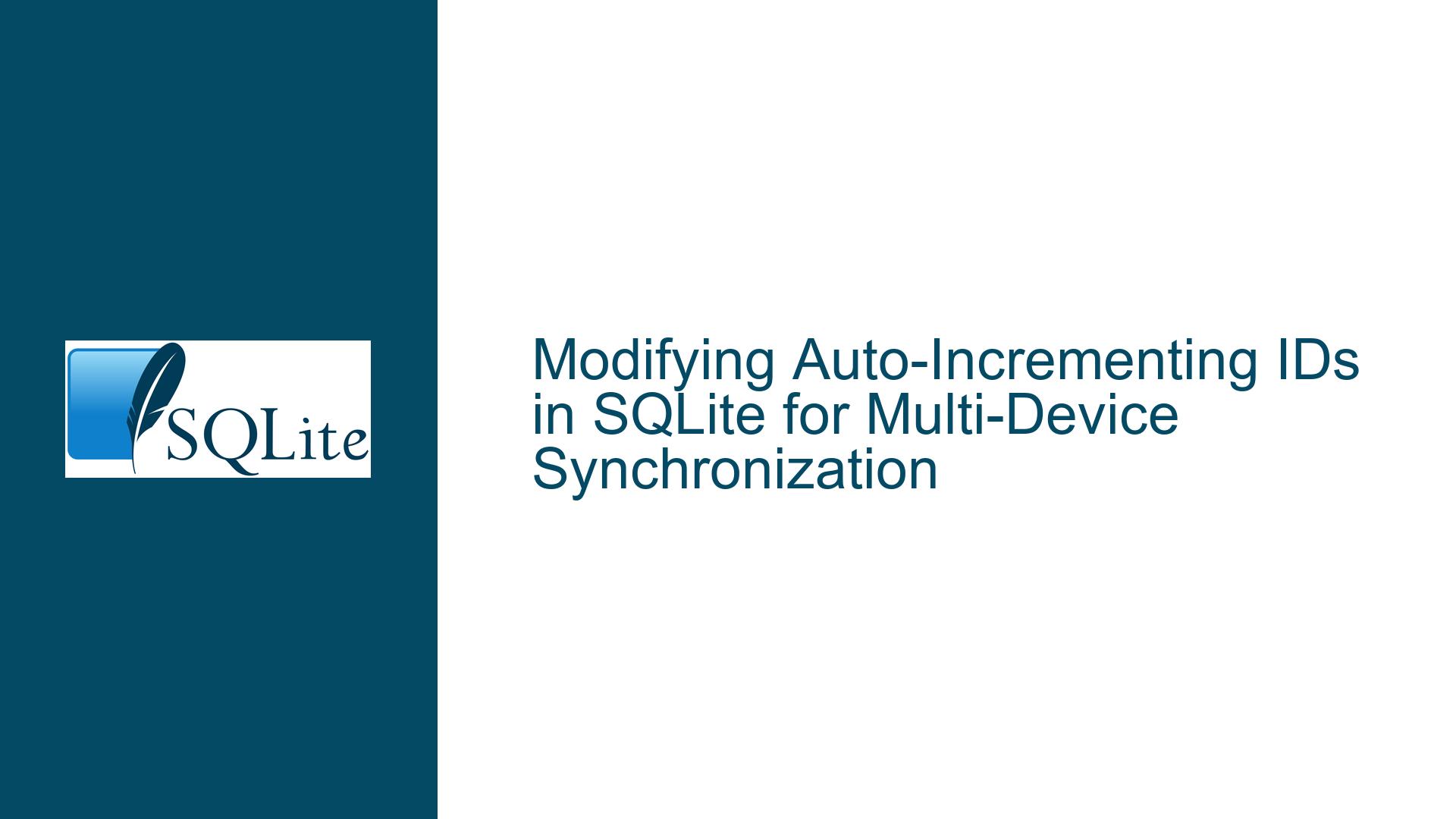Modifying Auto-Incrementing IDs in SQLite for Multi-Device Synchronization
Issue Overview: Conflicting Requirements for Custom ID Generation and SQLite’s Auto-Increment Behavior
The core challenge involves reconciling SQLite’s built-in auto-increment mechanisms with a requirement to generate device-specific primary keys that avoid synchronization conflicts across multiple databases. When a table uses INTEGER PRIMARY KEY AUTOINCREMENT, SQLite assigns monotonically increasing values starting at 1. However, when identical schemas exist on separate devices (e.g., mobile apps, distributed systems), these auto-generated IDs collide during synchronization, causing referential integrity failures in foreign key relationships.
For example, Device A inserts a row with id=1, and Device B inserts another row with id=1. When merged, these rows violate uniqueness constraints or create ambiguity in foreign key references. The goal is to modify SQLite’s behavior such that:
- Device A generates IDs starting at a custom base value (e.g.,
10000001). - Device B uses a different base (e.g.,
20000001). - Both devices increment their respective sequences independently.
The initial attempts to override the id column using a BEFORE INSERT trigger failed because triggers cannot directly modify the rowid (aliased as id in this case) after it has been assigned by SQLite’s internal logic. This limitation arises from SQLite’s design, where the rowid is determined during the early stages of row insertion and cannot be altered through standard DML operations within triggers.
The conflict stems from two opposing requirements:
- SQLite’s Auto-Increment Logic: The
AUTOINCREMENTkeyword enforces strict monotonicity by reserving the next availablerowidvalue in thesqlite_sequencesystem table. This preventsrowidreuse even after row deletions. - Custom ID Generation: Overriding the default
rowidassignment to inject device-specific offsets requires bypassing or modifying SQLite’s internal sequence management.
Possible Causes: Misalignment Between SQLite’s Rowid Management and Custom ID Requirements
1. Misunderstanding the Role of INTEGER PRIMARY KEY and AUTOINCREMENT
SQLite treats INTEGER PRIMARY KEY columns as aliases for the underlying rowid. When AUTOINCREMENT is added, SQLite enforces stricter guarantees:
- The
rowidwill always increase. - Deleted
rowidvalues are never reused. - The next
rowidis derived from the maximum existingrowidor the value stored insqlite_sequence.
However, AUTOINCREMENT is often unnecessary. Without it, SQLite will assign a rowid equal to one greater than the largest existing rowid. If the largest rowid is deleted, SQLite may reuse it. The presence of AUTOINCREMENT introduces overhead by requiring a write to sqlite_sequence on every insert.
2. Trigger Limitations in Modifying rowid
The BEFORE INSERT trigger in the original example attempted to update the id column using:
UPDATE todo SET id = 9999 WHERE rowid = NEW.rowid;
This approach fails because:
- The
rowidis assigned after the trigger executes. At trigger runtime,NEW.rowidisNULL. - Modifying the
idcolumn of the same row within the trigger would require direct assignment toNEW.id, but SQLite prohibits this forrowidaliases.
3. Inadequate Synchronization Strategy for Auto-Generated IDs
Distributed systems that rely on centralized ID generation (e.g., using a server) avoid collisions by design. However, in peer-to-peer synchronization scenarios without a coordinator, devices must generate globally unique IDs. SQLite’s default auto-increment does not support this, necessitating custom solutions such as:
- Composite keys (device ID + local ID).
- UUIDs (at the cost of storage and indexing efficiency).
- Offset-based ID ranges (e.g., Device A:
1-1000, Device B:1001-2000).
Troubleshooting Steps, Solutions & Fixes: Implementing Custom ID Generation Without Modifying SQLite Source Code
Step 1: Eliminate AUTOINCREMENT and Use Standard INTEGER PRIMARY KEY
Remove AUTOINCREMENT from the table definition:
CREATE TABLE notes (id INTEGER PRIMARY KEY, content TEXT);
This allows manual insertion of id values while still permitting SQLite to auto-generate rowid when id is omitted.
Step 2: Use Triggers to Assign Custom IDs
Create a BEFORE INSERT trigger that populates id with a device-specific offset:
CREATE TRIGGER assign_custom_id
BEFORE INSERT ON notes
FOR EACH ROW
WHEN NEW.id IS NULL
BEGIN
SELECT COALESCE(MAX(id), 10000000) + 1 INTO NEW.id FROM notes;
END;
This trigger:
- Checks if
NEW.idisNULL(i.e., the user did not provide an explicitid). - Calculates the next
idas one greater than the current maximum, defaulting to10000001if the table is empty.
Limitations:
- Concurrent writes may cause race conditions (use
BEGIN EXCLUSIVE TRANSACTIONto mitigate). - Gaps in the sequence may occur if inserts are rolled back.
Step 3: Seed the Initial ID via sqlite_sequence Manipulation
SQLite automatically creates an entry in sqlite_sequence for tables with AUTOINCREMENT. For standard INTEGER PRIMARY KEY tables, you can manually insert or update sqlite_sequence:
INSERT INTO sqlite_sequence (name, seq) VALUES ('notes', 10000000);
Subsequent inserts that omit id will auto-generate 10000001, 10000002, etc.
Caution: Direct manipulation of sqlite_sequence is undocumented and may not work reliably across SQLite versions.
Step 4: Implement Application-Layer ID Generation
Generate IDs in the application code and perform explicit inserts:
def insert_note(content):
max_id = execute_sql("SELECT COALESCE(MAX(id), 10000000) FROM notes")
new_id = max_id + 1
execute_sql("INSERT INTO notes (id, content) VALUES (?, ?)", (new_id, content))
Advantages:
- Full control over ID assignment.
- Avoids trigger-related complexity.
Disadvantages:
- Requires modifying all insert operations in the application.
Step 5: Use UUIDs for Universally Unique IDs
Replace INTEGER PRIMARY KEY with a TEXT PRIMARY KEY and generate UUIDs:
CREATE TABLE notes (id TEXT PRIMARY KEY, content TEXT);
import uuid
execute_sql("INSERT INTO notes (id, content) VALUES (?, ?)", (str(uuid.uuid4()), "content"))
Trade-offs:
- UUIDs consume more storage (16 bytes vs. 4-8 bytes for integers).
- Indexing and querying UUIDs is less efficient than integers.
Step 6: Modify SQLite Source Code to Customize Auto-Increment Logic
For scenarios requiring absolute control over ID generation, modify SQLite’s internal handling of rowid:
Locate the
sqlite3VdbeExecFunction invdbe.c:
This function processes SQL statements. Look for theOP_Sequenceopcode, which retrieves the next sequence value fromsqlite_sequence.Add a Device-Specific Offset:
Modify the sequence value before it is assigned to therowid. For example:// In vdbe.c, around line 1234 (exact location varies by version) if (pOp->p1 == 0) { // Original code: seq = sqlite3Atoi(sqlite3_column_text(pStmt, 0)); seq = sqlite3Atoi(sqlite3_column_text(pStmt, 0)) + DEVICE_OFFSET; }Replace
DEVICE_OFFSETwith a compile-time or runtime configurable value (e.g.,10000000).Rebuild SQLite:
Compile the modified source and link it into your SDK.
Risks:
- Custom SQLite builds are harder to maintain and may introduce compatibility issues.
- Overriding
rowidlogic may destabilize other SQLite features.
Step 7: Use a Virtual Table with Custom ID Generation
Create a virtual table that delegates ID generation to a user-defined function:
CREATE VIRTUAL TABLE notes USING custom_module(device_offset 10000000);
Implement the custom_module to manage IDs internally.
Complexity:
- Requires writing a SQLite extension in C.
- Provides maximal flexibility but adds deployment overhead.
Final Recommendation: Hybrid Approach
- Use application-layer ID generation with a
BEFORE INSERTtrigger as a fallback. - Avoid
AUTOINCREMENTunless strict monotonicity is required. - For synchronization, pair local IDs with device identifiers (e.g.,
PRIMARY KEY (device_id, local_id)).
This strategy balances simplicity, performance, and scalability while avoiding the pitfalls of SQLite source modification.






